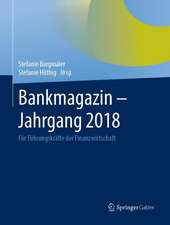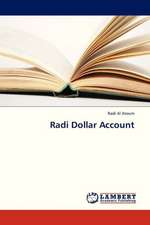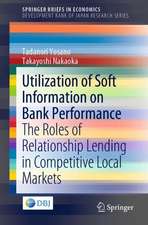Banking and Finance in West Germany (RLE Banking & Finance): Routledge Library Editions: Banking & Finance
Autor Hans Francke, Michael Hudsonen Limba Engleză Hardback – 25 mai 2012
The book emphasizes the crucial role played by the autonomy of the Bundesbank and it explains with clear illustrations the instruments available to it to conduct monetary policy. It analyses the type of monetary target adopted by the Bundesbank in the early 1970s and deals with the ‘transferability’ of the West German financial system to other countries. Wherever relevant, parallels and differences between that system and the ones operating in the US and UK are pointed out.
Din seria Routledge Library Editions: Banking & Finance
- 18%
 Preț: 1005.04 lei
Preț: 1005.04 lei - 33%
 Preț: 530.66 lei
Preț: 530.66 lei - 33%
 Preț: 13444.74 lei
Preț: 13444.74 lei - 18%
 Preț: 1007.12 lei
Preț: 1007.12 lei - 36%
 Preț: 854.69 lei
Preț: 854.69 lei - 18%
 Preț: 1121.25 lei
Preț: 1121.25 lei - 18%
 Preț: 891.61 lei
Preț: 891.61 lei - 18%
 Preț: 1006.43 lei
Preț: 1006.43 lei - 18%
 Preț: 784.07 lei
Preț: 784.07 lei - 34%
 Preț: 766.85 lei
Preț: 766.85 lei - 34%
 Preț: 681.92 lei
Preț: 681.92 lei - 34%
 Preț: 766.12 lei
Preț: 766.12 lei - 34%
 Preț: 766.85 lei
Preț: 766.85 lei - 34%
 Preț: 762.53 lei
Preț: 762.53 lei - 22%
 Preț: 327.96 lei
Preț: 327.96 lei - 21%
 Preț: 348.31 lei
Preț: 348.31 lei - 18%
 Preț: 1002.95 lei
Preț: 1002.95 lei - 34%
 Preț: 624.79 lei
Preț: 624.79 lei - 34%
 Preț: 626.22 lei
Preț: 626.22 lei - 21%
 Preț: 332.17 lei
Preț: 332.17 lei - 34%
 Preț: 597.33 lei
Preț: 597.33 lei - 18%
 Preț: 1004.34 lei
Preț: 1004.34 lei - 34%
 Preț: 625.16 lei
Preț: 625.16 lei -
 Preț: 419.11 lei
Preț: 419.11 lei - 18%
 Preț: 1003.99 lei
Preț: 1003.99 lei - 34%
 Preț: 997.28 lei
Preț: 997.28 lei - 34%
 Preț: 625.16 lei
Preț: 625.16 lei - 18%
 Preț: 1065.06 lei
Preț: 1065.06 lei - 34%
 Preț: 995.66 lei
Preț: 995.66 lei - 18%
 Preț: 1009.21 lei
Preț: 1009.21 lei -
 Preț: 127.54 lei
Preț: 127.54 lei - 34%
 Preț: 767.93 lei
Preț: 767.93 lei - 34%
 Preț: 625.68 lei
Preț: 625.68 lei - 34%
 Preț: 825.06 lei
Preț: 825.06 lei - 18%
 Preț: 1002.80 lei
Preț: 1002.80 lei - 34%
 Preț: 767.93 lei
Preț: 767.93 lei - 18%
 Preț: 1062.16 lei
Preț: 1062.16 lei
Preț: 313.40 lei
Preț vechi: 400.46 lei
-22% Nou
Puncte Express: 470
Preț estimativ în valută:
59.97€ • 62.77$ • 49.91£
59.97€ • 62.77$ • 49.91£
Carte tipărită la comandă
Livrare economică 31 martie-14 aprilie
Preluare comenzi: 021 569.72.76
Specificații
ISBN-13: 9780415528580
ISBN-10: 0415528585
Pagini: 178
Dimensiuni: 156 x 234 mm
Greutate: 0.5 kg
Ediția:1
Editura: Taylor & Francis
Colecția Routledge
Seria Routledge Library Editions: Banking & Finance
Locul publicării:Oxford, United Kingdom
ISBN-10: 0415528585
Pagini: 178
Dimensiuni: 156 x 234 mm
Greutate: 0.5 kg
Ediția:1
Editura: Taylor & Francis
Colecția Routledge
Seria Routledge Library Editions: Banking & Finance
Locul publicării:Oxford, United Kingdom
Public țintă
General, Postgraduate, Professional, and UndergraduateCuprins
1. An Historical Introduction and An Overview of The Book 2. The Deutsche Bundesbank 3. The Credit Institutions in the Federal Republic of Germany 4. The Financial Markets 5. The Instruments of Monetary Policy 6. Monetary Targets in the Federal Republic 7. The Future Development of the System.
Notă biografică
Hans-Hermann Francke, Michael Hudson
Descriere
This is a clear guide to the German financial system. It begins by outlining its historical development, emphasising the growth of close ties between the banking system and industry, and goes on to describe in details the nature of the credit institutions in general and the money and capital markets.
The book emphasizes the crucial role played by the autonomy of the Bundesbank and it explains with clear illustrations the instruments available to it to conduct monetary policy. It analyses the type of monetary target adopted by the Bundesbank in the early 1970s and deals with the ‘transferability’ of the West German financial system to other countries. Wherever relevant, parallels and differences between that system and the ones operating in the US and UK are pointed out.
The book emphasizes the crucial role played by the autonomy of the Bundesbank and it explains with clear illustrations the instruments available to it to conduct monetary policy. It analyses the type of monetary target adopted by the Bundesbank in the early 1970s and deals with the ‘transferability’ of the West German financial system to other countries. Wherever relevant, parallels and differences between that system and the ones operating in the US and UK are pointed out.






















